
Concept explainers
Draw all resonance structures of the conjugate bases formed by removal of the labeled protons
a.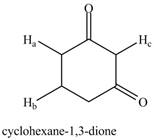 b.
b.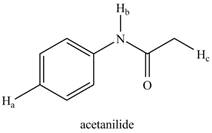
(a)
Interpretation: The resonance structure of the conjugate bases formed by the removal of the labeled protons
Concept introduction: Most of the organic structures cannot be represented using single Lewis structure. Therefore, there exists more than one Lewis structure for representing a molecule or ion. These structures are known as resonance structures. These are the hypothetical structures and do not specify the exact structure. These resonance structure combine together to give resonance hybrid that is lower in energy and is the most stable structure.
The delocalization of electrons results in the formation resonance structure.
Answer to Problem 19.50P
The resonance structure of the conjugate bases formed by the removal of the labeled protons

Figure 1
The increasing order of acidity of protons is
Explanation of Solution
The given compound is,
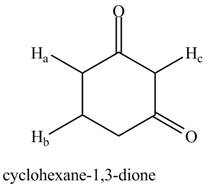
Figure 2
The conjugate base formed by the removal of
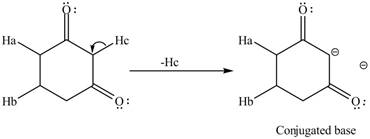
Figure 3
Therefore, the resonance structure of the conjugate base formed by the removal of the

Figure 4
The conjugate base formed by the removal of

Figure 5
Therefore, the resonance structure of the conjugate base formed by the removal of the
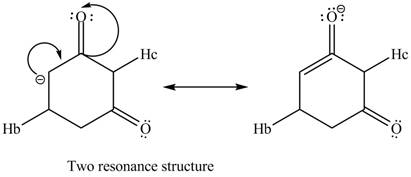
Figure 6
The stability of resonance structures depends upon the following rules:
• The stability of resonance structure is more if it possesses more bonds and fewer charges.
• Resonance structure will be more stable if atoms of the resonance structure have complete octet.
• The stability of resonance structure is more if negative charge is on more electronegative atom
The removal of

Figure 7
Proton acidity depends upon the stability of conjugated bases. More the number of resonance structures more will be the stability of molecule. Therefore, the increasing order of acidity of protons is
The resonance structures of the conjugate bases formed by the removal of the labeled protons
(b)
Interpretation: The resonance structure of the conjugate bases formed by the removal of the labeled protons
Concept introduction: Most of the organic structures cannot be represented using single Lewis structure. Therefore, there exists more than one Lewis structure for representing a molecule or ion. These structures are known as resonance structures. These are the hypothetical structures and do not specify the exact structure. These resonance structure combine together to give resonance hybrid that is lower in energy and is the most stable structure.
The delocalization of electrons results in the formation resonance structure.
Answer to Problem 19.50P
The resonance structure of the conjugate bases formed by the removal of the labeled protons
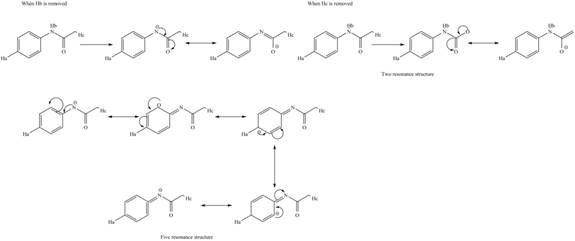
Figure 8
The increasing order of acidity of protons is
Explanation of Solution
The given compound is,

Figure 9
The conjugate base formed by the removal of

Figure 10
Therefore, the resonance structure of the conjugate base formed by the removal of the

Figure 11
Similarly, the resonance structure of the conjugate base formed by the removal of the

Figure 12
The stability of resonance structures depends upon the following rules:
• The stability of resonance structure is more if it possesses more bonds and fewer charges.
• Resonance structure will be more stable if atoms of the resonance structure have complete octet.
• The stability of resonance structure is more if negative charge is on more electronegative atom
The removal of

Figure 13
Proton acidity depends upon the stability of conjugated bases. More the number of resonance structures more will be the stability of molecule. Therefore, the increasing order of acidity of protons is
The resonance structures of the conjugate bases formed by the removal of the labeled protons
Want to see more full solutions like this?
Chapter 19 Solutions
Package: Loose Leaf for Organic Chemistry with Biological Topics with Connect Access Card
- Most ceramic materials have low thermal conductivities because:(a) Electron mobility is strongly restricted due to their strong ionic-covalent bonding.(b) False, in general they are excellent thermal conductors (they are used in ovens).(c) Electron mobility is dependent on T and therefore they are poor conductors at high temperatures.(d) Electron mobility is very restricted by secondary bonds.arrow_forwardResistivity and electrical conductivity.(a) In metals, resistivity decreases.(b) In metals, resistivity decreases and conductivity in semiconductors also decreases with increasing temperature.(c) With increasing temperature, resistivity in metals and conductivity in semiconductors also increases.(d) None of the above.arrow_forwardState the difference between concrete and Portland cement.(a) There are no differences, in concrete the chemical composition is silicates and in cement aluminates.(b) The chemical composition of concrete is based on silicates and in cement aluminates.(c) Concrete is composed of aggregates bound by cement and cement "only" contains different minerals.(d) Cement is aggregates bound by concrete.arrow_forward
- Amorphous polymers are usually transparent and semi-crystalline polymers are usually opaque. Correct?(a) No. They are all made up of polymer chains. True if they were monomers.(b) Yes. The arrangement of the chains determines the passage of light.(c) No. It is the other way around.(d) Crystallinity or amorphousness does not affect the transparency or opacity of the material.arrow_forwardThe name ferrites refers to a family of(a) ceramic materials that exhibit ferrimagnetic behavior due to their ionic composition.(b) polymeric materials that exhibit ferrimagnetic behavior due to their ionic composition.(c) concrete-based materials that exhibit ferrimagnetic behavior due to their ionic composition.(d) superconducting materials that exhibit ferrimagnetic behavior due to their ionic composition.arrow_forwardState the two main factors affecting ion packing in the solid state.(a) Number of covalent bonds and their unsaturation.(b) Mechanical properties and degradation temperature.(c) Number of crystalline phases present and grain size.(d) Electroneutrality and ion size.arrow_forward
- The ceramic materials alumina (Al2O3) and chromium oxide (Cr2O3) form an isomorphic phase diagram. The solubility will be(a) unlimited of one ceramic in the other.(b) very limited depending on the weight % of Al2O3(c) very limited depending on the weight % of Cr2O3(d) partial of one ceramic in the other.arrow_forwardAmong the main characteristics of optical fibers, indicate which of the following is not included:(a) Opacity and Rigidity(b) Flexibility(c) Transparency(d) Low thicknessarrow_forwardMost ceramic materials have low thermal conductivities because(a) Electron mobility is strongly restricted due to their strong ionic-covalent bonding.(b) False, in general they are excellent thermal conductors (they are used in ovens).(c) Electron mobility is dependent on T and therefore they are poor conductors at high temperatures.(d) Electron mobility is highly restricted by secondary bonds.arrow_forward
- Si increases its conductivity when doped with Ga and P.(a) True, because the conduction mechanism is due to electrons and holes generated by Ga and P as the case may be.(b) True, because a completely different compound is generated.(c) False, because when impurities are introduced, the opposite occurs.(d) False, because the conductivity of Si is only determined by the increase in temperature, which must be controlled.arrow_forwardIndicate whether a configuration and a microstate are the same:a) Yesb) No, a microstate encompasses several configurationsc) No, a configuration is the same as a macrostated) No, a configuration encompasses several microstatesarrow_forwardThe representation of a one-dimensional velocity distribution function for a gas, with increasing temperature the maximum occurs for vi = 0 m/s. Correct?arrow_forward
 Organic Chemistry: A Guided InquiryChemistryISBN:9780618974122Author:Andrei StraumanisPublisher:Cengage Learning
Organic Chemistry: A Guided InquiryChemistryISBN:9780618974122Author:Andrei StraumanisPublisher:Cengage Learning Organic ChemistryChemistryISBN:9781305580350Author:William H. Brown, Brent L. Iverson, Eric Anslyn, Christopher S. FootePublisher:Cengage Learning
Organic ChemistryChemistryISBN:9781305580350Author:William H. Brown, Brent L. Iverson, Eric Anslyn, Christopher S. FootePublisher:Cengage Learning


